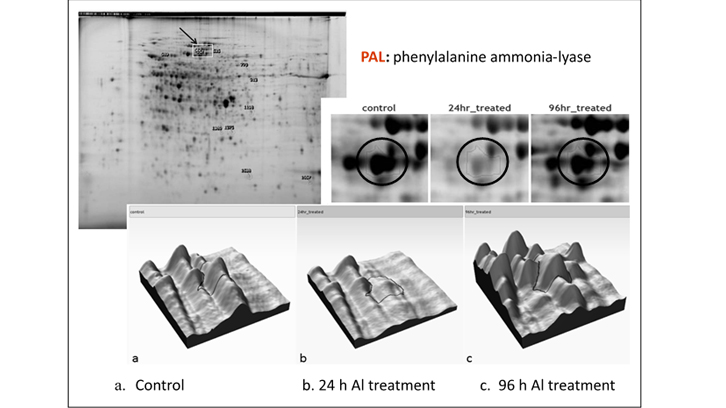Proteomics helps to understand the extreme resistance of Urochloa decumbens to aluminium

A team from the Plant Physiology Laboratory from the UAB Ecology and Animal & Vegetal Biology and Ecology has studied through proteomic analysis the mechanisms by which the species Urochloa decumbens has an extreme resistance to Aluminium toxicity, revealing that there are 11 proteins involved in this mechanisms of which 6 have been identified.
Aluminium toxicity as well as phosphorus, magnesium and calcium deficiency are characteristic features of tropical acid soils. These factors severely affect growth and root architecture in sensitive plants. Among adapted plants, Urochloa decumbens is one with the most extreme Al resistance. This species can serve as a model for studying the underlying mechanisms. Urochloa decumbens is a fodder grass with C-type photosynthesis native to Africa, but currently widely used in cultivation in tropical soils around the world due to its high growth and productivity in these conditions.
The mechanisms by which this species has extreme resistance to Al toxicity are still not well known. In a former study we found that the full expression of resistance requires a period of about 72-96 hours which is preceded by a sensitivity phase of between 24-48 hours. Her ewe made for the first approach using proteomics to clarify Al resistance mechanisms in this species. The root proteome along with root exudates and root elongation growth were analyzed during the first 96 hours after starting exposure of plants to 0 or 200 μM Al in hydroponics.
The citric and oxalate exudation was limited to the sensitivity phase, confirming that in contrast to other species organic acid exudation is not a main mechanism of Al tolerance in U. decumbens. The proteomic analysis revealed that only 11 proteins showed Al induced changes in their abundance. Unfortunately, only 6 proteins could be identified.
During the sensitive phase (24 hours), phenylalanine ammonia lyase (PAL), methionine synthase (MS) and deoxymugineic acid synthase (DMAs) decreased their levels while acid phosphatase increased. Coinciding with the recovering of root elongation (tolerance phase, 96 h) PAL and MS returned to their initial levels, while DMAs remained low. After 96 hours, γ-carbonic anhydrase (γ-AC) and adenylate kinase (AK) along with two unidentified proteins increased their levels.
Our results indicate that the alarm phase is related to the mobilization of phosphorus, decreased absorption of iron, reduction of the phenolic synthesis and stimulation of the oxidation of organic acids. In the resistance phase, the biosynthesis of phenols and methionine was restored, but not the mobilization of Iron. The maximum expression of resistance was related to an increase in γ-AC associated with mitochondrial complex I, and to enhanced levels of AK, indicating, respectively, an increase in respiration and a better provision of ATP and Mg for ATP synthase.
The future of work is to identify the five remaining proteins that show changes in abundance due to treatment with Al and which can provide us further clues to the mechanism of the extraordinary high Al resistance in U. decumbens.
Dra Roser Tolrà, Dra Charlotte Poschenrieder
Plant Physiology Laboratory,
Department BABVE, Bioscience Faculty,
Universitat Autònoma de Barcelona
Department BABVE, Bioscience Faculty,
Universitat Autònoma de Barcelona
References
Catalina Arroyave, Roser Tolrà, Livia Chaves, Marcelo Claro de Souza, Charlotte Poschenrieder A proteomic approach to the mechanisms underlying activation of aluminium resistance in roots of Urochloa decumbens. Journal of Inorganic Biochemistry 181 (2018) 145–151


